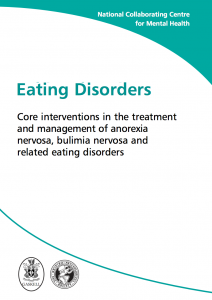
A general misconception about anorexia is that it’s just about eating and ‘being thin’, but it’s more complex than that. The illness affects multiple aspects of a person’s life, and often goes hand in hand with other psychological issues such as low mood, or excessive worry. In addition, the jury is still out on the exact cause of anorexia and the best treatment.
Those with very severe anorexia, who don’t respond to treatment outside of hospital, may need an inpatient stay. It follows that if anorexia is a complex illness, treatments should aim to address these complex issues, rather than just focus on attitudes relating to eating and shape, right?
Well, this is what “current” (published 10 years ago!) National Institute for Clinical Excellence (NICE) guidelines recommend: individuals who stay in hospital should receive treatment that focuses not only on eating, but wider psychosocial issues. However, these recommendations are based on expert opinions and clinical experience rather that good-quality evidence.
Moreover, a hospital stay does not guarantee recovery. Many patients find that they are unable to sustain an increased weight, and relapse back into anorexia. Therefore, treatment during this critical time should aim to provide psychological support that reduces a patient’s tendency to relapse when returning home.
So, do these kind of complex treatments work in a hospital setting, and do they reduce relapse rates?
This is where a recent study published in the Psychotherapy and Psychosomatics journal fits in. This Randomised Controlled Trial (RCT) set out to identify:
- What proportion of patients with severe anorexia are able to complete an inpatient Enhanced Cognitive Behavioural Therapy (CBT-E) program?
- Amongst those who complete the treatment, what is their outcome?
- Are the changes sustained over a 6 and 12 month period?

The NICE eating disorders guidance is due to be updated soon, but no date has yet been announced for the next update
Methods
This RCT was carried out in one inpatient unit in Northern Italy. Referrals to the inpatient unit were from various secondary care sources.
Participants:
Individuals (aged 14-65 years old) were recruited who:
- Met DSM-IV diagnostic criteria for anorexia nervosa
- Required inpatient treatment, either because of a failure of outpatient treatment, or because the anorexia could not be managed safely on an outpatient basis
- Had no evidence of an acute psychotic state, or current substance abuse
Interventions:
Two programs of inpatient CBT-E were utilised, both of which were derived from the outpatient version of CBT-E. In both programmes:
- Sessions were delivered in both an individual and group format
- Assistance with eating was given at the beginning of hospitalization
- Patients were allowed to go outside the hospital, and likely triggers were identified on a case-by-case basis 6 weeks prior to discharge. These were then addressed in individual sessions
- Significant others were involved in trying to create a stress-free environment for the patient to return home to
- The first 4 weeks focused only on eating disorder psychopathology
However, the two programmes also differed in several key regards, described below.
CBT-Ef (focused):
- Sessions focused on the features of the eating disorder:
- Completing weight restoration
- Over-evaluation of weight and shape
- Dietary restraint
- Binge eating and purging
CBT-Eb (broad):
- In addition to the eating disorder features covered in CBT-Ef sessions also addressed:
- Mood intolerance
- Clinical perfectionism
- Low self esteem
- Interpersonal difficulties
Eighty (female = 78) eligible participants were recruited; 42 patients were randomized to the CBT-Ef and 38 patients to the CBT-Eb.
Outcomes:
Measures were taken before treatment, after treatment, at 6 months and 12 months. The following were measured:
- Body weight and Body Mass Index (BMI)
- Eating Disorder Features as measured by the Eating Disorders Examination (EDE)
- General Psychiatric Features (GSI) as measured by the Brief Symptom Inventory (BSI)

Patients received both individual and group therapy sessions
Results
There was no difference between the two programs for BMI, weight gain, eating disorder psychopathology, general psychiatric features, or proportion of completers at the end of treatment or at follow up. Therefore all results are reported across both treatments.
Body Weight and BMI
- Mean weight gain was 12.7kg
- Mean weight after treatment (50.1kg) decreased at 6 months (47.1kg) but remained stable at 12 months (46.9kg)
- Mean BMI increased from 14.3 before treatment to 18.9 after treatment
- Mean BMI decreased to 17.8 at 6 months and remained at this level at 12 months
Eating Disorder Features & General Psychiatric Features
- Mean global EDE scores decreased by 2. This was maintained at both 6 and 12 months
- Mean GSI scores decreased by 1. This was maintained at both 6 and 12 months
Proportion of Completion
- 90% of patients completed the inpatient programs
- Of those that completed the inpatient treatment, 95.8% completed the 6 month follow-up and 94.4% completed the 12 month follow-up.

There were no differences at any point between the two inpatient programmes
Conclusions
The researchers concluded:
This study has demonstrated that inpatient CBT-E is well accepted by patients with severe anorexia nervosa and the response is promising. Ninety percent completed the program and most improved substantially. Deterioration after discharge did occur but it was not marked and it was for a limited period of time.
Comments
The authors acknowledge that they cannot conclude that the changes were due to specific components of CBT-E as no other comparison group was included due to logistical reasons. This also makes comparisons between existing inpatient treatments and CBT-E difficult.
The results may not be generalizable to the UK since the inpatient setting was in Northern Italy, and inpatient referrals may differ when compared to the UK. For example, the South London and Maudsley Eating Disorders inpatient service admits patients with a BMI of less than 15, whereas a quarter of the current sample had a BMI of over 16 and the mean BMI of the total sample was 14.9.
During the follow-up period, almost all patients attended various outpatient treatments. This makes interpretation of the findings more difficult.
Furthermore, the current sample size of 80 patients is fairly small for a RCT, and this may have limited any potential differences between the two programmes. This lack of difference between the two programmes led to the researchers grouping the results. Although there were no significant differences between the CBT-Ef and CBT-Eb characteristics at baseline it is hard to say whether the results were exactly the same.
Additionally, no specific measures of mood intolerance, interpersonal difficulties, self-esteem or clinical perfectionism were used. This means that any potential change in these variables may not have been measured.
Despite these limitations, the RCT indicates the potential of CBT-E for use in an inpatient setting, although further research is needed to examine whether this is significantly better than current inpatient treatment, both immediately after treatment and at follow up.

Although the study shows progress, more research is needed to allow us to form firm conclusions as to the best inpatient treatments for anorexia.
Links
Dalle Grave, R., Calugi, S., Conti, M., Doll, H., & Fairburn, C. (2013) Inpatient cognitive behaviour therapy for anorexia nervosa: a randomized controlled trial. Psychotherapy and Psychosomatics, 82, 390-398.
Eating disorders: Core interventions in the treatment and management of anorexia nervosa, bulimia nervosa and related eating disorders (PDF). National Institute for Health and Care Excellence. Clinical Guideline 9, 2004.
Eating Disorders Pathway, NICE.
For more information or advice about eating disorders please see beat.


RCT compares two different versions of enhanced cognitive behavioural therapy for anorexia nervosa in an inpat… http://t.co/PUU8SDf9M0
My latest @Mental_Elf blog: http://t.co/DVMeuZpfcY RCT compares 2 types of enhanced CBT for inpatient anorexia @aedweb @beatED @EDCDenver
Enhanced CBT is “well accepted by patients with severe anorexia nervosa” says new RCT http://t.co/JHNioYurx3
RCT compares two different versions of enhanced cognitive behavioural therapy for anorexia… http://t.co/lLaxleTsGv
CBT in treating anorexia. Any followers have experience of CBT relating to treating a mental health condition? http://t.co/BHzFjbbcLL
Latest @Mental_Elf blog: http://t.co/DVMeuZpfcY Enhanced CBT well received by those with anorexia in inpatient setting @BPSOfficial
@MaxineHoward333 tells us that more research is needed to decide the best inpatient treatments for anorexia http://t.co/JHNioYurx3
@NICEcomms Please can you tell us when your eating disorders guidance will next be updated? http://t.co/JHNioYurx3 @MaxineHoward333
@Mental_Elf @MaxineHoward333 an update is being planned into our work schedule following 3rd review of guideline http://t.co/3JqDsH7Mic
RCT compares two different versions of enhanced cognitive behavioural therapy for anorexia nervosa for inpatients http://t.co/L20A5gEXPG
Don’t miss: @MaxineHoward333 on an RCT comparing two forms of enhanced CBT for the treatment of anorexic inpatients http://t.co/JHNioYurx3
Mental Elf: RCT compares two different versions of enhanced cognitive behavioural therapy for anorexia nervosa in… http://t.co/EcLvY1EhBk
RCT compares two different versions of enhanced cognitive behavioural therapy for anorexia nervosa http://t.co/3uwmBgavAU
Thanks for sharing this study. Each person’s recovery journey and needs can be so different, that it is important that each finds an individualized treatment approach that focuses on healing the whole self, not just their symptoms. It is a long journey for recovery that will last long after an inpatient or outpatient treatment program.